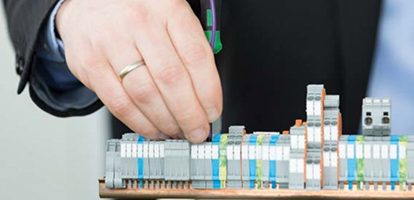



Switchgear producers are challenged to steadily reduce their costs. At the same time, the number of networked and interactive systems has consistently increased the demands on electrical distribution networks. Ultimately, the competitive strength of a switchgear manufacturer is determined by how it combines technical expertise with production efficiency, knowing the latter is greatly influenced by wiring expenses. Therefore, streamlined wiring plays an important role for switchgear producers. Burkhard Niemann shares his insight on the philosophies WAGO follows in order to offer solutions that truly create value for switchgear manufacturers.
Mr. Niemann, whenever efficiency in wiring is discussed, the term “push-in” arises. Where does WAGO stand regarding this technology?
In general, we view it positively. Otherwise, we would not have integrated push-in technology into our terminal blocks. Here are a few examples: our TOPJOB® S Rail-Mounted Terminal Block System, the WINSTA® Pluggable Connection System and several diverse PCB terminal blocks.
Why does your answer to the question about push-in technology seem restrained? Does WAGO need to play catch up?
No, we certainly do not need to play catch up. After all, we invented push-in connection technology with the Push-in CAGE CLAMP® and were the first company to bring it to market. However, we did not focus on push-in technology during the launch of TOPJOB® S; we primarily focused on the particularly compact size of our rail-mounted terminal blocks.
Why? Didn’t you consider push-in technology to be an advantage for users?
The possibility of inserting conductors directly into the terminal block, without needing to open the clamping unit with a tool, is indeed a functional aspect that offers users greater value. There is no doubt about that. However, we believe it is not the most important. There are many other points that play an important role in evaluating rail-mounted terminal blocks.
Such as?
OK, so you know that when you only have to insert a few conductors, push-in technology is a great thing. However, when you are making a large number of connections, the older connection method of opening the clamping unit with an activation tool for conductor termination is still more convenient. This is the point: The tool remains in the operating slot until termination is complete. This allows the user to mark the clamping unit with the screwdriver and frees up both hands for hassle-free wiring.
Does this mean that you consider the attention that the topic is currently receiving to be unjustified?
What I think is that push-in technology by itself does not establish the value of a terminal block. There are certainly other aspects that provide users with an edge, and these are just as important — if not more — than directly inserting a conductor. The product features that suppliers like WAGO emphasize in their communications have more to do with the general philosophy that a company follows during product development.
And what is WAGO’s philosophy behind rail-mounted terminal blocks?
Our philosophy has always been to offer a universal terminal block that can do everything — the “one-for-all” terminal block — instead of offering many different products for diverse applications. And, this terminal block should be as compact as possible. Our goal has always been to save control cabinet space; beyond that, safety has always played an enormously important role at WAGO.
The “one-for-all” terminal block?
Yes. In order to satisfy the many demands that users place on connection technology, I can either develop many solutions for many problems, or one solution to solve them all. So we chose the second path, leading to the development of our TOPJOB® S Rail-Mounted Terminal Block System. A push-in terminal block that accommodates solid, stranded and ferruled, fine-stranded conductors via direct insertion, yet also allows the connection of fine-stranded conductors without ferrules. It functions in nearly any application anywhere in the world from industrial applications and buildings to those subjected to extreme temperature conditions. One terminal block, available as single-, double- and triple-deck blocks, as well as in variants like fuse, disconnect, test, electric motor wiring, diode and LED terminal blocks.
And what advantage is there, in your opinion, of relying on a universal terminal block, instead of developing individualized solutions for different demands? All-arounders are often criticized as being able to do a little of everything but nothing really well.
I don’t believe this holds true at all for our rail-mounted terminal system. Quite the contrary! Unlike many comparable products, our TOPJOB® S can always be loaded with the nominal voltage of the maximum conductor size. A single-deck terminal block with a nominal cross-section of 2.5 mm² can accommodate 4 mm² conductors (solid or fine-stranded) and be loaded with a current of 32 A. And actually, this the ultimate capability of a rail-mounted terminal block: to transfer current within a compact space with as little loss as possible. This allows the user to choose between saving space in the control cabinet by selecting the smaller terminal block for a larger conductor, or using a suitable terminal block to incorporate a buffer for eventually moving up in conductor size. We rely on the universal terminal block, because we see the advantage in always having the right product in your pocket or in your warehouse.
OK, the idea that the right product is missing from the warehouse — that can happen with a universal rail-mounted terminal block as well, right?
Of course. Until we reach the “Industry 4.0” terminal block that automatically orders itself, we still have to face that possibility. But perhaps I can clarify what I mean by using our solutions for commoning and marking. In addition to push-in type jumper bars and staggered jumpers, we offer an adjacent jumper for continuous commoning in the 2002 Series. It can connect an endless number of terminal blocks to each other using one jumper slot.
Many suppliers solve this problem by offering a jumper strip with 30, 40, or 50 contact pins. However, the user then has to cut the jumper to the length that the process requires. This creates a disadvantage because the flat metal surface that is created at the cut’s edge can potentially conduct electricity, leading to a safety hazard. This is why WAGO offers the continuous jumper as an individual component; it can connect two terminal blocks to each other and then join them seamlessly. If, during commissioning, another function is added, the user simply adds another continuous jumper.
OK, that actually saves users one or two trips to the warehouse.
Yes, because I only need one type of jumper to common many terminal blocks.
And what does the marking have to do with this?
That’s simple. We offer a device that can print marking strips, labels and markers. And because our rail-mounted terminal blocks have the same marking level — regardless of different cross-section sizes — they can easily be equipped with continuous marking strips. These are printed as one piece and then simply pressed onto the terminal block assembly — done!
It sounds as if you are quite satisfied with your rail-mounted terminal block program, Mr. Niemann. Have you reached a point where there is really nothing more to improve?
Yes, or course I am satisfied. And, of course there is always room for incremental improvements. But the discussions about different technologies, like the ones we had 15 to 20 years ago, are no longer relevant to rail-mounted terminal blocks. Rail-mounted terminal blocks from different suppliers are differentiated in the details. Therefore, in my opinion, the one who will win the competition is the one who best understands how exploit product details to create true value for customers. And we still have a few good ideas for that in mind.
Mr. Niemann, thank you very much for the conversation.